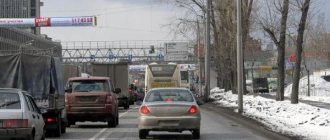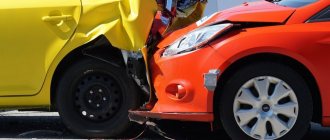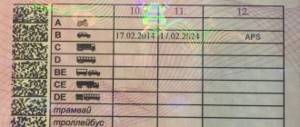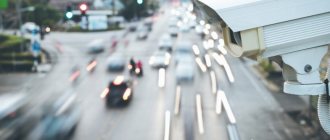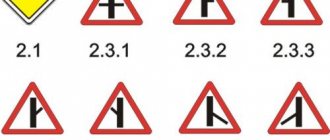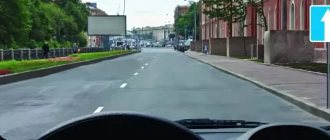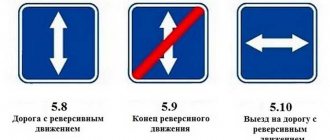What it looks like and what it is intended for
This sign belongs to the warning category. It is designed in the form of a triangle with a red frame. A black silhouette of a tram is depicted on a white background. This sign is permanent, and it is impossible to find an analogy installed temporarily for a simple reason - no one makes rails for a short period of time.
The purpose of this sign is to warn all road users that there will be an intersection with tram tracks ahead and the car driver will probably have to give way to the route vehicle or its passengers.
IMPORTANT! All warning signs are intended to alert the driver to unexpected incidents and dangers that may require an emergency stop and other safety measures.
Features of installing a road sign 1.5
Installation of sign 1.5 of the Russian Federation Traffic Regulations has installation requirements depending on the location of the tram line within the populated area and beyond.
If the tram passes outside the city, then warning sign 1.5 should inform the driver in advance, namely 150-300 meters ahead. In the city, the sign is installed at a distance of 50-100 meters from the approaching rail bed.
The difference in the distance of the sign installed in the city and outside it is related to the speed limit.
In the city, the maximum speed of the driver should not be more than 60 km/h, and outside the populated area up to 90 km/h.
However, it is also possible to indicate a different distance, provided that sign 1.5 is duplicated together with sign 8.1.1. Road sign 8.1.1 will indicate in this case the specific distance to the intersection with the tram line.
What are the rules for placing a sign?
All road signs are installed in accordance with GOST R 52289-2019. It says that sign 1.5 “Intersection with a tram line” is installed before crossing a road with tram tracks outside the intersection, as well as before intersections (squares) through which tram tracks pass, when the visibility distance of the tracks is less than 50 meters.
It is allowed to install the sign at a distance different from that provided by the standard, however, in this case there must be a plate 8.1.1 indicating the specific footage.
IMPORTANT! Signs must be installed in such a way that they are not blocked by green spaces, banners and other roadside elements.
Features of the sign
The “Intersection with a tram line” sign has significant features that must be taken into account when driving on the road:
- With simultaneous traffic rights (when the vehicles are in equivalent conditions), tram drivers have priority.
- Outside intersections where tram tracks cross the path of trackless vehicles, the tram has priority, except when leaving the depot.
Sign 1.5 requires the driver to be attentive, since in most cases he will have to give way to the tram.
Sign Intersection with tram line
Road sign 1.5 - intersection with a tram line must be installed on the territory of a populated area where road transport moves together with rail transport.
The meaning of sign 1.5 of the Russian Traffic Regulations is that car drivers should be especially careful, since in the event of a collision, a multi-ton tram can cause significant harm to health and property.
In addition, it is worth remembering that this type of transport is a passenger one, in which there are people, and therefore has an advantage in movement.
The difference between these types of transport is that the tram travels strictly along a dedicated rail lane and does not have the technical ability to go around an obstacle.
Road sign 1.5 should discipline the driver when encountering rail vehicles and at the same time warn about possible danger when colliding with them.
Possible violations by motorists
Motorists often forget that a route rail vehicle has advantages on the road. Among the most common violations are collisions with tram tracks, failure to provide priority, and failure to allow passengers on a route vehicle to pass. In order not to become the culprit of an accident and not get fined, you need to remember the rules for traveling with trams.
- Regardless of the direction of travel, the tram has priority at the intersection of equivalent roads. At controlled intersections, a tram has traffic priority only if it is given a permitting signal at the traffic light;
- It is possible to drive onto tram tracks for the purpose of detour, U-turn or turn if they are located on the left side of the main road along with it and there are no prohibitions on this maneuver in the area. The driver of the car is obliged to maneuver in such a way as not to interfere with public and private transport;
- If the road and the tram line are separated by continuous markings, then you cannot drive onto the tracks. If there is a constructive separation between the zones of cars and rail vehicles (for example, different levels), collisions on the tracks are prohibited;
- If there is a traffic jam on the road, you cannot go around it along the tram tracks. A traffic jam is not an obstacle on the road;
- If the tram does not have a special traffic light, then it moves according to the instructions of a regular (vehicle) control device. Thus, if motorists have a green light on and the same signal acts on the tram, then the tram moves first;
- in case of any collision with a tram lane, there should be no interference with rail transport;
- the only case when the tram driver is obliged to let all traffic participants pass is when leaving the depot, since the depot is an adjacent territory.
IMPORTANT! Tram stops can be located directly on the roadway, without additional stopping complexes. Drivers must remember that they are required to let passengers get off the tram or on their way to board the tram.
If a motorist provokes an accident involving a tram, then the administration of the city electric transport can actually file a claim to recover compensation for downtime and losses that the enterprise suffered in connection with the accident. There is no fine in the Code of Administrative Offenses of the Russian Federation for downtime of public transport, but this does not mean that the carrier is forced to silently suffer losses due to the negligence of the motorist. Just remember that tram tracks are for trams, not cars.
When to give in?
The tram almost always has the right of way. Drivers should remember that given equal priorities on the road, this vehicle should be allowed to pass. Rail transport cannot take advantage only in individual cases.
The tram gives way
According to traffic rules, a tram loses its advantage in three situations:
- when driving at the signal of an arrow that turns on at a traffic light along with a red or yellow light. The tram gives way to traffic coming from other directions;
- when approaching an intersection on a secondary road;
- at the exit from the depot, when crossing the road with tracks.
Drivers are subject to liability for violations
Drivers will be held administratively liable for failure to comply with traffic rules.
- For driving into the tram lane of oncoming traffic while avoiding an obstacle, a fine of 1000-1500 rubles is provided. You can go around obstacles on rails in the same direction, but even a partial drive into the oncoming line will entail a fine.
- If you entered an oncoming tramway without any reason, the fine will be 5,000 rubles.
- For failure to provide priority to a tram - a fine of 500 rubles.
- For driving on paths that are not intended for a car to run over (for example, they have a fence or are raised to a level above or below the road surface) - a fine of 500 rubles.
- If there is a road sign “Driving in lanes” at an intersection, and the driver enters the tram tracks in the same direction, he will be fined 500 rubles.
- For not allowing a tram passenger (who is boarding or, on the contrary, disembarking from the tram) to pass, the motorist can be fined in the amount of 1,500 to 2,500 rubles.
- For ignoring the requirements of road signs, the driver faces a fine of 500 rubles. If a motorist violates the marking requirements, the fine can reach 5,000 rubles. When crossing a double solid line, there is a risk of losing your driver's license.
- For deliberate and unreasonable driving onto the tram rails of the opposite direction, the driver of the car may be deprived of his license for a period of three to six months.
Repeated violations result in more severe penalties.
IMPORTANT! Before imposing a punishment, the traffic police must provide evidence of the motorist’s guilt. They can be photographs or video recordings from cameras, as well as testimony of witnesses. When stopped by a traffic police inspector, additional evidence may not be needed, since his word in itself is evidence. The driver has the right to appeal the fine in court, using the same methods of proving innocence (photos, videos, witness statements).
| Did not find an answer to your question? Call a lawyer! Moscow: +7 (499) 110-89-42 St. Petersburg: +7 (812) 385-56-34 Russia: +7 (499) 755-96-84 |
A tram is a kind of city train. It moves at a speed close to that of a vehicle, but at the same time has less maneuverability and is slower to brake. A collision with a tram can cause serious harm to the health of the motorist and passengers, so care and compliance with traffic rules at intersections with the tram line are especially important.
Responsibility for violating traffic rules
If traffic rules are not observed, sanctions are imposed in accordance with the articles of the Code of Administrative Offences.
- driving into the path of oncoming traffic (Articles 12.15, 12.16) - a fine of up to RUB 5,000 or deprivation of rights for up to six months;
- stopping or parking a car on tram tracks (Article 12.19) - fine ₽1,500.
Thus, rail transport gives way to other vehicles only in the three described cases. The rest of the time you should always remember its advantage. Follow these rules carefully to avoid endangering yourself and your passengers.
Common Questions
- What is priority: traffic lights or traffic controller signals? Actually, the traffic controller at the post says that he “commands” on this section of the road. Traffic lights, road signs and markings lose their priority in front of the traffic controller.
- What is the penalty for failure to follow instructions? In case of driving against the prohibition of an authorized person, the driver faces a fine of 800 to 1 thousand rubles. In case of repeated violation, the amount of punishment will increase to 5 thousand rubles. A 6-month driver's license suspension also applies. But pedestrians who ignore the inspector’s signals will lose 1 thousand rubles.
Easy to remember
Not every person is able to quickly remember the decoding of various gestures of a road service employee. There are quite a lot of them, and the speed of learning new information varies from person to person. However, you can speed up the memorization process.
Effective techniques
Drivers of cars and trams use the “sleeve technique” to quickly memorize signals. It is enough to remember that those cars that seem to drive into the inspector’s sleeve have the right to drive. If not a single limb of the traffic controller points to the car, then you should wait for the next signal.
However, this technique applies exclusively to trackless vehicles, but tram drivers continue to move when they can not only drive into the sleeve, but also leave it. This suggests that car drivers should move only in the direction in which the inspector’s hand is pointing.
The “no-crossing rule” is also considered an effective technique for motorists. Its meaning is that drivers are prohibited from moving in the direction crossed by the inspector’s hands.
Rules in verses and pictures
Rephrasing the rules into short but succinct poems makes them much easier to remember. The most common of them are:
- If the stick points to the left, drive like a queen.
- You don’t fall into the sleeve - you wait for a signal.
- If the policeman’s back is to you, then don’t rock the boat and stand still.
- If the stick is pointing towards your mouth, make a right turn.
- The traffic cop's back is a wall.
Visualizing the rules also speeds up the process of memorizing them. Therefore, when studying the traffic controller’s gestures, you can resort to the help of educational pictures.
Training video
You can speed up the learning process with the help of videos. In this case, the information will be absorbed simultaneously by visual and auditory memory. In addition, having seen how to react to a particular signal from the inspector and why, it will be easier to reproduce the skill in practice.
One such training video is presented below.
Types of traffic controller signals for a section of road with a tram
A traffic controller is an official with the authority to control road traffic. Its signals help reduce the number of dangerous situations on the roads to almost zero. However, no traffic controller is able to prevent an accident if his gestures are misinterpreted.
Every road user must be able to decipher the traffic controller’s instructions, most of which are divided into warning, permitting and prohibiting.
Warning
The traffic controller, with his hand raised, reports that any maneuver in this area is prohibited. In this case, the location of the vehicle or its further path does not matter.
In addition, it is important to understand that the warning gesture applies to all road users, including pedestrians.
If at the moment of the signal the car was in the intersection area and the pedestrian was crossing the road, all traffic participants must complete the maneuver as quickly as possible.
The warning helps to relieve congestion on the road for the fastest possible passage of special vehicles. Its analogue is the yellow color of a traffic light, so it is followed by a turn of the body and a change in the position of the traffic controller’s hands or the sound of a whistle.

